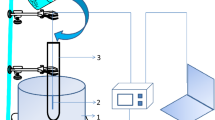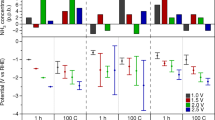Abstract
We have derived an analytical expression for the time dependent NO concentration from NONOate donors in the presence of oxygen for the process of NO release from NO donors following autoxidation. This analytical solution incorporates the kinetics of the releases with the autoxidation and is used to fit the simulated NO concentration profile to the experimental data. This allows one to determine the NO release rate constant, k 1, the NO release stoichiometric coefficient, v NO, and the NO autoxidation reaction rate constant, k 2. This analytical solution also allows us to predict the real NO concentration released from NO donors under aerobic conditions, while v NO is reportedly two under aerobic conditions, it falls to lower values in the presence of oxygen.
Access this chapter
Tax calculation will be finalised at checkout
Purchases are for personal use only
Similar content being viewed by others
References
Gladwin MT, Kim-Shapiro DB (2008) The functional nitrite reductase activity of the heme-globins. Blood 112:2636–2647
Banaji M, Mallet A, Elwell CE et al (2008) A model of brain circulation and metabolism: NIRS signal changes during physiological challenges. PLoS Comput Biol 4(11):e1000212. doi:10.1371/journal.pcbi.1000212, BRAINSIGNALS: an open source modelling environment http://www.medphys.ucl.ac.uk/braincirc/download/repos/NIRSmodel.html
Rong Z, Cooper C (2013) Modelling hemoglobin nitrite reductase activity as a mechanism of hypoxic vasodilation? Adv Exp Med Bio 789:361–368
Rong Z, Banaji M, Moroz T, Cooper CE (2013) Can mitochondrial cytochrome oxidase mediate hypoxic vasodilation via nitric oxide metabolism? Adv Exp Med Bio 765:231–238
Rong Z, Cooper C (2016) Hemoglobin effects on nitric oxide mediated hypoxic vasodilation. Adv Exp Med Bio 876:121–127
Brown M, Wade J, Marshall J (1985) Fundamental importance of arterial oxygen content in the regulation of cerebral blood flow in man. Brain 108:81–93
Ford PC, Wink DA, Stanbury DM (1993) Autoxidation kinetics of aqueous nitric oxide. FEBS Lett 326:1–3
Möller MN, Li Q, Vitturi DA et al (2007) Membrane “Lens” effect: focusing the formation of reactive nitrogen oxide from the NO/O2 reaction. Chem Res Toxicol 20:709–714
Schmidt K, Desch W, Klatt P et al (1997) Release of nitric oxide from donors with known half life: a mathematical model for calculating nitric oxide concentrations in aerobic solutions. Naunyn-Schmiedeberg’s Arch Pharmacol 355:457–462
Griveau S, Dumézy C, Goldner P et al (2007) Electrochemical analysis of the kinetics of nitric oxide release from two diazeniumdiolates in buffered aqueous solution. Electrochem Comm 9:2551–2556
Silkstone RS, Mason MG, Nicholls P, Cooper CE (2012) Nitrogen dioxide oxidizes mitochondrial cytochrome c. Free Rad Bio Med 52:80–87
Pogrebnaya VL, Usov AP, Baranov AV et al (1995) Oxidation of nitric oxide by oxygen in the liquid phase. J Appl Chem USSR 48:1004–1007
Wink DA, Darbyshire JF, Nims RW et al (1993) Reactions of the bioregulatory agent nitric oxide in oxygenated aqueous media: determination of the kinetics for oxidation and nitrosation by intermediates generated in the NO/O2 reaction. Chem Res Toxicol 6(1):23–27
Goldstein S, Czapski G (1995) Kinetics of nitric oxide autoxidation in aqueous solution in the absence and presence of various reductants. The nature of the intermediates. J Am Chem Soc 117:12078–12084
Wehrli FW, Rodgers ZB, Jain V et al (2014) Acad Radiol 21:207–214
Acknowledgments
I thank Professor Michael Wilson (University of Essex) for helpful discussion and help with manuscript preparation and Professor Peter Nicholls (University of Essex) for the experimental data.
Author information
Authors and Affiliations
Corresponding author
Editor information
Editors and Affiliations
Rights and permissions
Copyright information
© 2016 Springer International Publishing Switzerland
About this paper
Cite this paper
Rong, Z., Ye, Z. (2016). Analytical Expression for the NO Concentration Profile Following NONOate Decomposition in the Presence of Oxygen. In: Luo, Q., Li, L., Harrison, D., Shi, H., Bruley, D. (eds) Oxygen Transport to Tissue XXXVIII. Advances in Experimental Medicine and Biology, vol 923. Springer, Cham. https://doi.org/10.1007/978-3-319-38810-6_57
Download citation
DOI: https://doi.org/10.1007/978-3-319-38810-6_57
Published:
Publisher Name: Springer, Cham
Print ISBN: 978-3-319-38808-3
Online ISBN: 978-3-319-38810-6
eBook Packages: Biomedical and Life SciencesBiomedical and Life Sciences (R0)




